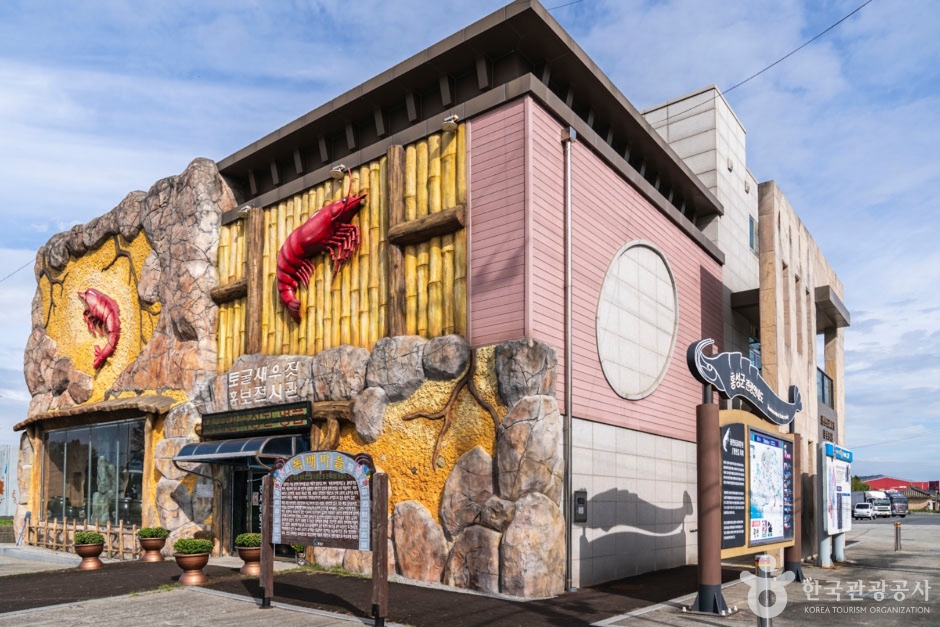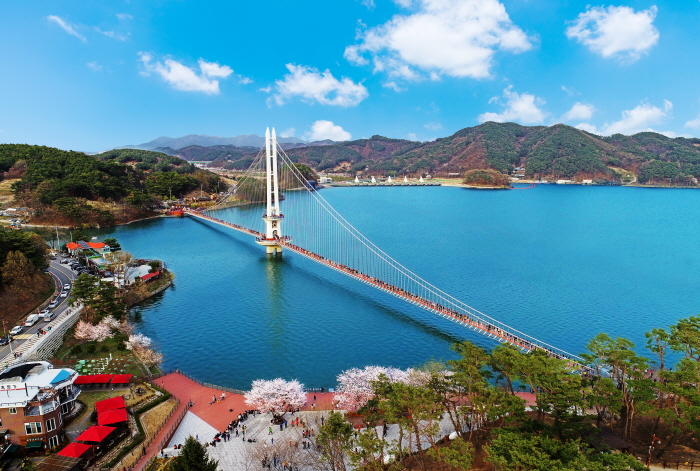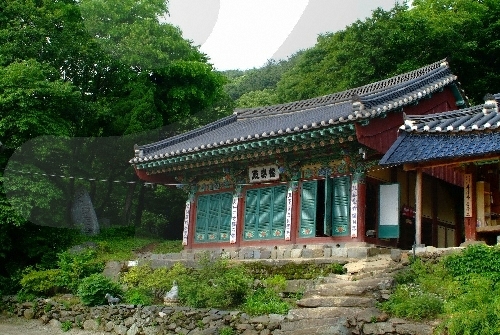Namdang Port (남당항)
16.4 Km 15674 2024-06-05
Namdang-ri, Hongseong-gun, Chungcheongnam-do
+82-41-630-1224
Namdang Port is a representative port on the West Coast. Known for having plenty of prawn, cockle, flat fish, rock fish and other types of seafood, the port draws visitors all year round. Cockles in particular are a local delicacy, usually enjoyed as cockle shabu shabu or charcoal-grilled cockle. A nearby attraction to visit is the bamboo grove of Jukdo Island
Gwangcheon Cave Salted Shrimp Complex (광천토굴새우젓단지)
16.4 Km 4623 2024-02-26
119, Gwangcheon-ro, Gwangcheon-eup, Hongseong-gun, Chungcheongnam-do
Gwangcheon Cave Salted Shrimp Complex is a collection of shops offering saeujeot (salted shrimp), a specialty of Gwangcheon. Gwangcheon’s proximity to the Yellow Sea makes it a famous place for jeotgal (salted seafood), particularly those made with shrimp. Gwangcheon’s saeujeot (salted shrimp) is stored and aged in a former mine cave tunnel, so it has great quality. There is even an exhibition hall dedicated to Gwangcheon cave salted shrimp. The Gwangcheon Cave Salted Shrimp & Dried Laver Festival is held in October.
Yedangho Suspension Bridge & Musical Fountain (예당호 출렁다리(음악분수))
17.0 Km 359 2021-02-10
161, Yedanggwangwang-ro, Yesan-gun, Chungcheongnam-do
+82-41-339-8282
Yedangho Suspension Bridge opened on April 6, 2019 as the longest suspension bridge in Korea with the length of 402 meters. With the addition of Slow Lake Road in October of the same year, visitors can now enjoy the beautiful scenery even more. There is a sculpture park around the lake, standing in harmony with the white suspension bridge.
A grand musical fountain was installed on April 25, 2020. The fountain is the widest in the nation, and shoots jets of water up 110 meters into the air. The fountain show lasts for 20 minutes, and uses bightly colored LED lights for an exciting performance.
Yedang Reservoir (예당저수지(예당관광지))
17.1 Km 27858 2024-06-04
Deungchon-ri, Eungbong-myeon, Yesan-gun, Chungcheongnam-do
+82-41-339-8285
Yedang Reservoir is a popular attraction that represents Yesan in Chungcheongnam-do. Main facilities include a monorail, suspension bridge, sculpture park, and campground, as well as restaurants, accommodations, and convenience facilities. There are also various themed walking trail and parking lots. Many people visit to see the Golden Tree, a tree that takes on a golden hue at sunset.
Gohyang Gul Susan (고향굴수산)
17.8 Km 21648 2024-03-04
8-5, 1061 Hongbo-ro, Cheonbuk-myeon, Boryeong-si, Chungcheongnam-do
041-641-8966
Gohyang Gul Susan is a restaurant specializing in oysters located within the Cheonbuk Oyster Complex. Oysters are the specialty of this place. Fresh oysters are paired with rice and vegetables harvested directly from the farm. The menu includes gul gui (grilled oysters), gul jjim (steamed oysters), gul jeon (pan-fried battered oyster), saeng gul (fresh oysters), dolsonn yeongyang gulbap (nutritious hot stone pot oyster rice), and gul kalguksu (noodle soup with oysters). Oysters are low in fat and rich in minerals, making them nutritious and flavorful. In December, the Cheonbuk Oyster Festival is held at the Cheonbuk Oyster Complex.
Cheonbuk Oyster Complex in Boryeong (보령 천북굴단지)
17.9 Km 35138 2024-06-05
Cheonbuk-myeon, Boryeong-si, Chungcheongnam-do
+82-41-930-0804
Cheonbuk Oyster Complex in Boryeong is a place near the Hongseong Embankment where various restaurants specializing in oysters are clustered. Boryeong is known for its abundant oyster production, with those caught between November and February considered the finest. In December, the Cheonbuk Oyster Festival is held, featuring events for tourists. Here, visitors can taste a variety of dishes made with oysters, including grilled oysters, raw oysters, and oyster rice.
Daeheung Sikdang (대흥식당)
18.1 Km 0 2024-02-21
37-1, Sudeoksaan-gil, Deoksan-myeon, Yesan-gun, Chungcheongnam-do
Daeheung Sikdang is an old restaurant that serves great sanchae (wild vegetables) cuisine at the entrance to Sudeoksa Temple, a famous Buddhist temple in Korea. Its signature menu is the dolsot deodeok jeongsik (hot stone pot rice and deodeok set menu), featuring fragrant deodeok and wild vegetable dishes prepared with care. There are other menus on offer, such as beoseot pajeon (mushroom and green onion pancake), ureong chomuchim (sweet and sour freshwater snail salad), dotori bindaetteok (acorn and mung bean pancake), dotorimuk (acorn jelly salad), and sundubu (soft bean curd). Side dishes include jogi gui (grilled yellow croaker), ori barbecue (duck barbecue), and doenjangguk (soybean paste soup).
Seosan Ganworam Hermitage (간월암(서산))
18.1 Km 55318 2023-01-02
119-29, Ganwoldo 1-gil, Seosan-si, Chungcheongnam-do
+82-41-668-6624
Ganworam is a small hermitage located in Ganwoldo-ri in Seosan-si, Chungcheongnam-do. Ganworam Hermitage was created by the Great Monk Muhak, the monk to King Taejo of the Joseon dynasty. The name of the hermitage is directly tied with Muhak himself as it is said Muhak became enlightened while meditating under the moon (wol means moon in Korean) at this hermitage. At low tide, Ganworam Hermitage is connected to shore via a natural walkway, but at high tide, the walkway is submerged and the hermitage becomes an island. At night time, in particular, the hermitage and its surrounding islets create a breathtaking view as the moonlight reflects off the sea.
Hongseong Jeongamsa Temple (정암사 (홍성))
18.3 Km 8355 2021-03-12
652, Oseo-gil, Hongseong-gun, Chungcheongnam-do
+82-41-641-0488
Jeongamsa Temple is a small rural temple situated halfway up Oseosan Mountain. There are few existing records that mention the temple’s beginning. Some suggest that it was built around AD 527 during the 5th year of Baekje King Seongwang’s reign, but there is little evidence to support this theory. The only reference alluding to a specific time is Yeojidoseo ("Detailed Survey of Korean Geography" published during the late Joseon dynasty). It states Jeongamsa Temple's location as on Oseosan Mountain, and Oseosan Mountain being surrounded by Hongsan Mountain and Baegwolsan Mountain and intersected by Hongju, Gyeolseong, and Boryeong. This indicates the temple was recognized in the mid-18th century and around the same time, Garamgo (a book about temples, published in the late 18th century) also states that Jeongamsa Temple is located approximately 11 kilometers to the east of Gyeolseonghyeon. It is still uncertain whether the temple referred to is Jeongamsa Temple on Oseosan Mountain.
Some foundation stones within the temple site measure 70-80 centimeters on each side. These stones indicate that the old Buddhist shrine of Jeongamsa Temple was laid out with five kan (Korean unit of measurement indicating the space between two pilars) at the front and three kan on the side. Future archaeological studies will help identify the true history of Jeongamsa Temple.
Seosan Buseoksa Temple (부석사(서산))
19.4 Km 16153 2021-11-23
243, Buseoksa-gil, Seosan-si, Chungcheongnam-do
+82-41-662-3824
Located on Dobisan Mountain in Seosan, Chungcheongnam-do, Buseoksa Temple was built by the Great Monk Uisang in 677, the 17th year of King Munmu of Silla, and was later rebuilt by Great Monk Muhak during the Joseon dynasty. The temple houses eight seated Buddha statues and attracts many visitors due to its magnificent surrounding scenery.




 English
English
 한국어
한국어 日本語
日本語 中文(简体)
中文(简体) Deutsch
Deutsch Français
Français Español
Español Русский
Русский